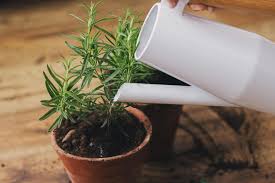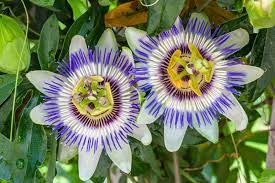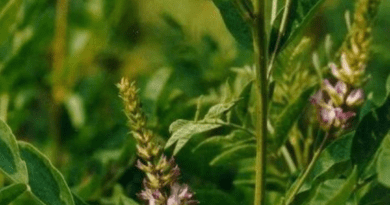7 Medicinal Health Benefits of Clerodendrum Infortunatum (Wild Jasmine)
Clerodendrum infortunatum, commonly known as “Wild Jasmine” or “Bharangi” in various regions, is a medicinal plant belonging to the family Lamiaceae. It is native to tropical and subtropical regions of Asia, including countries like India, Sri Lanka, Bangladesh and Myanmar.
This plant has a long history of traditional use in Ayurvedic and folk medicine systems for its therapeutic properties.
Clerodendrum infortunatum is a woody shrub that can grow up to 2-3 meters in height. It has simple, opposite leaves that are elliptical or ovate in shape with serrated edges.
The leaves are typically dark green and have a slightly rough texture. The plant produces tubular flowers arranged in clusters, with colors ranging from white to pale pink.
Read Also: 10 Medicinal Health Benefits of Pterocarpus soyauxii (African Teak)
The Medicinal Health Benefits of Clerodendrum Infortunatum (Wild Jasmine)

Here are some of the medicinal properties and health benefits of Clerodendrum infortunatum:
1. Respiratory Health: Clerodendrum infortunatum is highly regarded for its respiratory benefits. It is often used to address respiratory issues such as coughs, bronchitis, and asthma. The plant’s expectorant properties help to loosen and expel mucus from the respiratory passages, providing relief from congestion and promoting easier breathing.
For example, a decoction made from its leaves and roots can be consumed to alleviate cough and clear phlegm.
2. Anti-inflammatory and Analgesic: The plant contains compounds with anti-inflammatory and analgesic properties. This makes it useful for managing various inflammatory conditions such as arthritis and joint pains.
Applying a poultice or paste made from crushed Clerodendrum infortunatum leaves and stems to the affected area can help reduce pain and inflammation. Regular use might provide relief and improve mobility in those with joint discomfort.
3. Antimicrobial Effects: Clerodendrum infortunatum has shown antimicrobial activity against certain bacteria and fungi. It can be used to help fight infections and support the body’s immune response.
Incorporating the plant into one’s routine could contribute to the management of minor infections and promote overall immune health.
4. Immunomodulation: Some studies suggest that the plant’s compounds might have immunomodulatory effects, meaning they can regulate the immune system’s activity. This can be beneficial for individuals with immune-related disorders.
By influencing immune responses, Clerodendrum infortunatum might help the body maintain a balanced immune function.
5. Antioxidant Protection: The plant is reported to have antioxidant compounds that combat oxidative stress and free radical damage. Regular consumption of Clerodendrum infortunatum may contribute to reducing cellular damage and supporting overall well-being.
This antioxidant activity might help protect cells from premature aging and certain diseases.
6. Digestive Aid: Some traditional uses of Clerodendrum infortunatum include addressing digestive issues. It can be used to alleviate indigestion, bloating, and abdominal discomfort.
Consuming a diluted decoction or herbal tea made from its leaves might help soothe the digestive system and promote better digestion.
7. Anti-allergic Potential: Clerodendrum infortunatum has been explored for its potential anti-allergic properties. It might help manage allergic reactions by reducing inflammation and modulating the immune response.
While more research is needed in this area, it could offer a natural approach to addressing mild allergic symptoms.
Read Also: 10 Medicinal Health Benefits of Rauvolfia Mannii (African Snake Root)
Methods of Usage to Achieve the Medicinal Health Benefits of Clerodendrum Infortunatum (Wild Jasmine)
Here’s a detailed explanation of how Clerodendrum infortunatum can be used to achieve its medicinal health benefits:
1. Respiratory Health: To utilize its respiratory benefits, you can prepare a decoction using the leaves and roots of Clerodendrum infortunatum. Take a handful of dried Clerodendrum infortunatum leaves and roots. Boil them in about 2 cups of water until the water reduces to half.
Strain the decoction and let it cool slightly. Consume this herbal tea twice a day, preferably in the morning and evening. You can add honey for taste if desired. This decoction helps to clear phlegm, soothe the respiratory passages, and alleviate cough and congestion.
2. Anti-inflammatory and Analgesic: For addressing pain and inflammation, you can create a poultice. Crush fresh Clerodendrum infortunatum leaves and stems to make a paste. Apply this paste directly to the affected area.Cover the area with a clean cloth and leave it on for about 30 minutes.
Repeat this process 2-3 times a day as needed. The poultice can help reduce pain and swelling in joints or other inflamed areas.
3. Antimicrobial Effects: To harness its antimicrobial properties, you can prepare an infusion. Take a teaspoon of dried Clerodendrum infortunatum leaves. Place them in a cup of boiling water.
Let it steep for about 10 minutes, then strain. Drink this herbal infusion once or twice a day. Regular consumption of this infusion might support the body’s ability to fight off infections.
4. Immunomodulation: For potential immunomodulatory effects, you can use Clerodendrum infortunatum as part of your diet. Incorporate the leaves or roots into your cooking, such as adding them to soups or stews.
Alternatively, you can prepare a decoction as mentioned earlier and consume it regularly.By including the plant in your diet, you might support a balanced immune response.
5. Antioxidant Protection: To benefit from its antioxidant compounds, you can consume a decoction or infusion. Prepare a decoction or infusion using dried Clerodendrum infortunatum leaves or roots.
Consume it daily to introduce antioxidants into your system and combat oxidative stress. This practice could help protect cells from damage caused by free radicals.
6. Digestive Aid: For digestive support, you can consume a diluted herbal tea. Prepare a decoction using Clerodendrum infortunatum leaves or roots. Dilute the decoction with water to achieve a comfortable concentration.
Drink this diluted tea after meals to aid digestion. The herbal tea may help alleviate indigestion and promote better digestive function.
7. Anti-allergic Potential: While research is ongoing in this area, you can try using Clerodendrum infortunatum in a similar manner to other herbal remedies for allergies. Consume the herbal infusion or decoction regularly to potentially mitigate mild allergic symptoms.
The Side Effects of Using Clerodendrum Infortunatum Medicinal Plant
While Clerodendrum infortunatum has been traditionally used for its medicinal benefits, like any herbal remedy, it may also have potential side effects. Here are five possible side effects to be aware of:
1. Allergic Reactions: Some individuals might be allergic to Clerodendrum infortunatum or its components. Allergic reactions can range from mild skin irritation to more severe symptoms like itching, rash, swelling or difficulty breathing.
It’s important to perform a patch test before using it topically and to be cautious if you have known allergies to plants in the Lamiaceae family, which includes mint and sage.
2. Gastrointestinal Upset: Consuming Clerodendrum infortunatum in excessive amounts or without proper preparation could lead to gastrointestinal discomfort. This might include symptoms like nausea, vomiting, diarrhea or stomach cramps.
It’s advisable to follow recommended dosages and methods of preparation to minimize the risk of such side effects.
3. Drug Interactions: Like many herbal remedies, Clerodendrum infortunatum could potentially interact with certain medications. If you are taking prescription medications, especially those affecting the immune system, consult a healthcare professional before using this herb to avoid potential interactions that might affect the efficacy or safety of your medications.
4. Photosensitivity: Some individuals might experience increased sensitivity to sunlight (photosensitivity) after using Clerodendrum infortunatum topically. This could lead to skin irritation or sunburn more quickly than usual when exposed to the sun. If you’re planning to use preparations of this plant on your skin, be cautious about sun exposure and consider using sunscreen.
5. Pregnancy and Breastfeeding: There is limited information available regarding the safety of Clerodendrum infortunatum during pregnancy and breastfeeding. As a precaution, pregnant and breastfeeding women should avoid using this herb, as its effects on these conditions have not been well-studied, and there could be potential risks to the developing fetus or nursing infant.
Read Also: The Importance of Channels of Distribution and Selecting an Appropriate Channel








